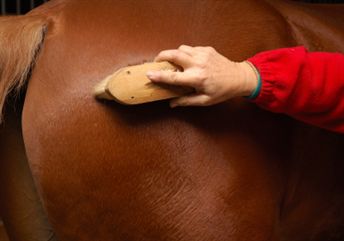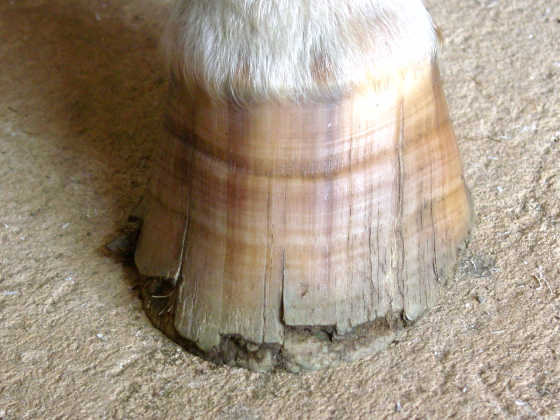When you arrive at the barn, you probably run to your horse's paddock/stall and retrieve them. As you walk up, take a minute to look: are they standing "normally"? Is Pookie bright eyed, pricked-eared? It takes some time to establish normal habits (does he rest his back leg? which one?) but turn your perceptiveness up to 11 and familiarize yourself with what is normal and what is not.
Most people bring your horse in and groom. If he's wearing a blanket, or a halter during turn out, check for rubs or damage to either item, especially if he's out with new horses, or unused to wearing them. Leg straps or the polls or hardware of a halter can rub, and it's good to catch those things NOW, and not when you find a big angry sore underneath them.
Normal! What a nice shiny coat!
As you brush, check for abnormal amounts of dandruff, or non-seasonal hair loss. Brush your way down the legs and notice tendon "normal" (think about it in levels of contrast - if the leg is puffy, the tendons are less defined) down the lower leg, the way the knee feels, feel below the fetlock, and familiarize yourself with the temperatures of all leg apparatuses as well as the hoof. As you pick out the foot, check out the shape of the foot, the frog's firmness, shape etc.
NOT normal!
Also make sure you are removing all of the mud you can from your horse come fall and spring - mud can hide injuries, create a breeding ground for all sorts of skin ailments and even cause cellulitus. Nobody wants to come to the barn to find a fat legged horse!
Knowing your horse's normals is very important, and can help you narrow down the problem when a mystery injury occurs. For example: My horse tends to stock up in her stall, but this goes down with exercise or turnout. Thus, when someone calls me and freaks out about her "legs looking puffy" after she's been in her stall, I don't get too concerned.
I'll cover some of the common horse maladies in another post, but being aware of all things "pony" means that you notice sooner when something goes awry. Your peace of mind, and your vet will thank you!
Ashley & Foxie


No comments:
Post a Comment